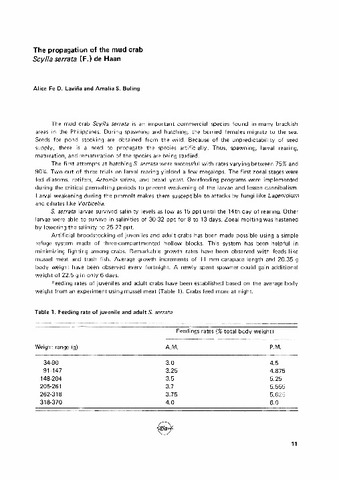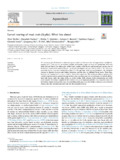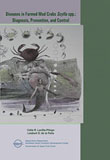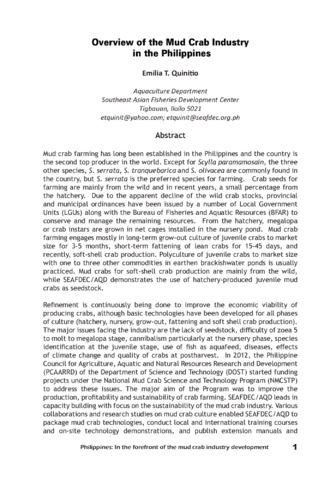The propagation of the mud crab Scylla serrata (F.) de Haan
| dc.contributor.author | Laviña, Alice Fe D. | |
| dc.contributor.author | Buling, Amalia S. | |
| dc.date.accessioned | 2015-07-16T01:52:27Z | |
| dc.date.available | 2015-07-16T01:52:27Z | |
| dc.date.issued | 1977 | |
| dc.identifier.citation | Laviña, A. F. D., & Buling, A. S. (1977). The propagation of the mud crab Scylla serrata (F.) de Haan. SEAFDEC Aquaculture Department Quarterly Research Report, 1(2), 11. | en |
| dc.identifier.uri | http://hdl.handle.net/10862/2287 | |
| dc.description | Extended abstract only. | en |
| dc.description.abstract | The mud crab Scylla serrata is an important commercial species found in many brackish areas in the Philippines. During spawning and hatching, the berried females migrate to the sea. Seeds for pond stocking are obtained from the wild. Because of the unpredictability of seed supply, there is a need to propagate the species artificially. Thus, spawning, larval rearing, maturation, and rematuration of the species are being studied. The first attempts at hatching S. serrata were successful with rates varying between 75% and 90%. Two out of three trials on larval rearing yielded a few megalops. The first zoeal stages were fed diatoms, rotifers, Artemia salina, and bread yeast. Overfeeding programs were implemented during the critical premolting periods to prevent weakening of the larvae and lessen cannibalism. Larval weakening during the premolt makes them susceptible to attacks by fungi like Lagenidium and ciliates like Vorticella. S. serrata larvae survived salinity levels as low as 15 ppt until the 14th day of rearing. Other larvae were able to survive in salinities of 30-32 ppt for 8 to 13 days. Zoeal molting was hastened by lowering the salinity to 25-27 ppt. Artificial broodstocking of juveniles and adult crabs has been made possible using a simple refuge system made of three-compartmented hollow blocks. This system has been helpful in minimizing fighting among crabs. Remarkable growth rates have been observed with feeds like mussel meat and trash fish. Average growth increments of 11 mm carapace length and 20 . 35 g body weight have been observed every fortnight. A newly spent spawner could gain additional weight of 22.5 g in only 6 days. Feeding rates of juveniles and adult crabs have been established based on the average body weight from an experiment using mussel meat. Crabs feed more at night. In another experiment, eyestalk ablation was found to be effective in inducing growth and mating. Aside from hastening the molting process, copulation is induced even among the small crabs (average carapace length = 55 mm). Natural mating lasts about 26 hr. A copulation which lasted for seven days with a break in between was observed. | en |
| dc.language.iso | en | en |
| dc.publisher | Aquaculture Department, Southeast Asian Fisheries Development Center | en |
| dc.subject | Scylla serrata | en |
| dc.subject | Philippines | en |
| dc.title | The propagation of the mud crab Scylla serrata (F.) de Haan | en |
| dc.type | Article | en |
| dc.citation.volume | 1 | en |
| dc.citation.issue | 2 | en |
| dc.citation.spage | 11 | en |
| dc.citation.journalTitle | SEAFDEC Aquaculture Department Quarterly Research Report | en |
| dc.subject.asfa | crustacean culture | en |
| dc.subject.asfa | experimental culture | en |
| dc.subject.asfa | salinity tolerance | en |
| dc.subject.asfa | larvae | en |
| dc.subject.asfa | artificial feeding | en |
| dc.subject.asfa | induced ovulation | en |
| dc.subject.scientificName | Scylla serrata | en |






